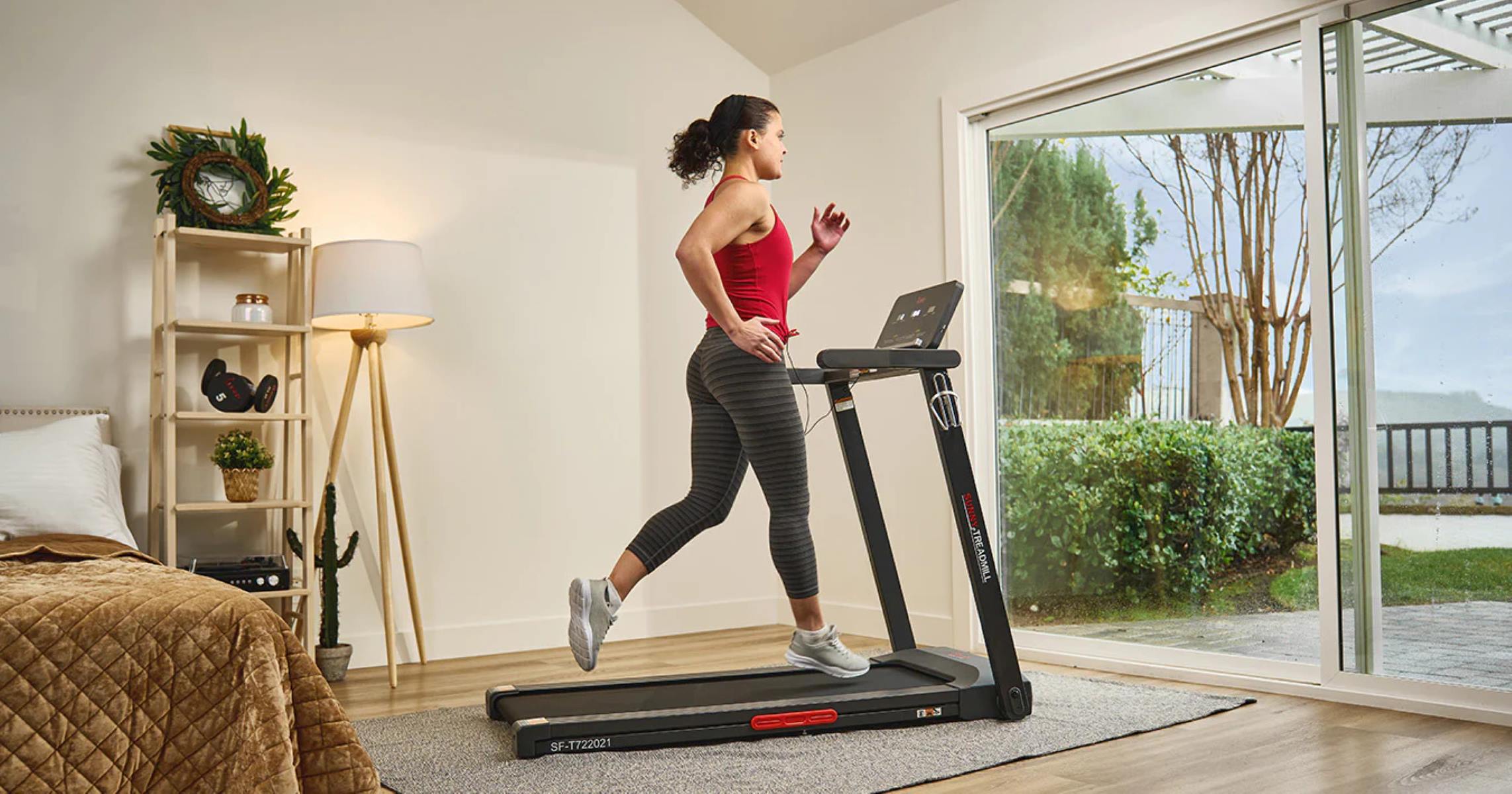Home>Misc>Featured>How Many Steps Do I Take For 30 Minutes On The Treadmill


Featured
How Many Steps Do I Take For 30 Minutes On The Treadmill
Modified: January 2, 2024
Discover how many steps you can take in just 30 minutes on a treadmill. Featured workout to keep you fit and active. Grab your running shoes and start counting your steps now!
Introduction
Welcome to the world of fitness, where every step counts towards improving your health and well-being. In today’s sedentary lifestyle, finding time for physical activity can be a challenge. However, with the convenience of a treadmill, you can clock in your daily steps and get closer to your fitness goals.
Walking on a treadmill is a popular form of exercise that can be done at any time, regardless of the weather conditions outside. Whether you are a beginner taking your first steps towards a healthier lifestyle or an experienced fitness enthusiast looking to amp up your workout routine, walking on a treadmill can provide numerous benefits for your body and mind.
In this article, we will explore the benefits of walking on a treadmill and delve into the fascinating world of step counting. Specifically, we will answer a common question: How many steps is 30 minutes on a treadmill? But before we get into the specifics, let’s take a look at why walking on a treadmill is such a beneficial exercise.
Now that we understand the benefits of walking on a treadmill, let’s dive into the exciting world of step counting and discover how it relates to your 30-minute treadmill session.
Benefits of Walking on a Treadmill
Walking on a treadmill offers a myriad of benefits for both your physical and mental well-being. Let’s take a closer look at some of the key advantages of incorporating this form of exercise into your daily routine.
- Cardiovascular Health: Walking on a treadmill is a fantastic way to improve your cardiovascular health. This low-impact exercise elevates your heart rate, increases blood circulation, and strengthens your heart muscles. Regular treadmill workouts can help reduce the risk of heart disease and improve overall cardiovascular fitness.
- Weight Management: Walking on a treadmill is an effective way to burn calories and manage weight. The number of calories burned during a treadmill walk depends on factors such as speed, duration, and individual body composition. By incorporating regular treadmill sessions into your routine, you can create a calorie deficit, leading to weight loss or weight maintenance.
- Joint-Friendly Exercise: Unlike high-impact activities such as running or jumping, walking on a treadmill is gentle on your joints. The cushioned surface of the treadmill reduces the impact on your knees, ankles, and hips, making it an excellent choice for individuals with joint issues or those recovering from injuries.
- Mental Well-being: Walking on a treadmill can do wonders for your mental health. Physical exercise releases endorphins, the “feel-good” hormones, which can help alleviate stress, improve mood, and combat symptoms of anxiety and depression. Whether you walk briskly or at a more leisurely pace, a treadmill workout can provide a much-needed mental boost.
- Convenience and Safety: One of the greatest advantages of walking on a treadmill is the convenience and safety it offers. You can exercise in the comfort of your own home or at the gym, regardless of the weather conditions outside. Treadmills also come equipped with safety features such as handrails and emergency stop buttons, providing a secure and controlled environment for your workout.
These are just a few of the many benefits that walking on a treadmill can provide. Whether you are aiming to improve your cardiovascular health, manage your weight, boost your mood, or simply incorporate more physical activity into your daily routine, walking on a treadmill is a fantastic option to consider.
Determining the Number of Steps in 30 Minutes
Now that we understand the benefits of walking on a treadmill, let’s explore how many steps you can expect to take during a 30-minute session. The number of steps can vary depending on factors such as your walking speed, stride length, and fitness level.
To determine the approximate number of steps in 30 minutes, it is helpful to know your average step count per mile. On average, it takes about 2,000 to 2,500 steps to complete one mile. Therefore, if you are walking at a moderate pace of 3 miles per hour, you can estimate taking around 6,000 to 7,500 steps in 30 minutes.
However, it is important to remember that everyone’s walking speed and stride length are different. For a more accurate estimation, you can calculate your steps per minute by dividing your total step count by the number of minutes you walked. Multiply this number by 30 to determine the approximate steps you would take in a 30-minute treadmill session.
If you have a fitness tracker or pedometer, it can provide you with a more precise step count during your treadmill workout. These devices use sensors to track your movement and provide real-time data on your steps, distance, and calories burned. They can also help you set goals and monitor your progress over time.
Keep in mind that the number of steps is just one way to measure your progress during a treadmill workout. It is also important to focus on other factors such as duration, intensity, and overall fitness improvement. Remember, the goal is to stay consistent and gradually increase your activity levels for optimal health benefits.
So, the next time you hop on a treadmill for a 30-minute walk, you can estimate your step count using the techniques mentioned above. However, don’t get too caught up in the numbers. The most important thing is to enjoy your workout, challenge yourself, and reap the incredible benefits that walking on a treadmill can offer.
Factors Affecting the Number of Steps
While the average step count per minute can provide a rough estimation of the number of steps you might take during a 30-minute treadmill walk, it is crucial to consider that several factors can influence the actual count. Understanding these factors can help you adjust your expectations and tailor your workouts accordingly.
1. Walking Speed: The speed at which you walk on the treadmill plays a significant role in determining your step count. Walking at a faster pace will naturally result in more steps taken within a given time frame, while a slower pace will yield fewer steps. Experiment with different speeds to find a balance that suits your fitness level and goals.
2. Stride Length: Your stride length, which is the distance covered by each step, can vary from person to person. Factors such as height, leg length, and flexibility can influence your stride length. Generally, taller individuals tend to have longer strides, resulting in fewer steps taken to cover the same distance compared to someone with a shorter stature.
3. Fitness Level: Your fitness level also impacts the number of steps you take during a 30-minute treadmill session. As your fitness improves, you may find yourself taking fewer steps to cover the same distance due to increased efficiency and stride length. Additionally, individuals with a higher fitness level may choose to incorporate intervals, incline variations, or other challenging factors into their workout, which can affect step count.
4. Walking Technique: Your walking technique can influence your step count as well. Maintain proper posture, engage your core muscles, swing your arms naturally, and drive through your heels with each step. These techniques can improve your efficiency and help you cover more ground with fewer steps.
5. Body Composition: Body composition, including factors such as weight and muscle mass, can affect the number of steps taken during a treadmill walk. Individuals with more weight or muscle mass may burn more energy and generally take more steps to cover a certain distance compared to someone with less weight or muscle mass.
6. Treadmill Settings: The settings on the treadmill, such as incline and resistance, can impact step count as well. Walking on an incline will require more effort and may result in a higher step count compared to walking on a flat surface. Similarly, increasing the resistance on a treadmill can make the workout more challenging and potentially increase the number of steps taken.
It is essential to recognize that these factors are not isolated and often work together to influence your step count. For instance, a combination of a higher walking speed, longer stride length, and increased fitness level can result in a significantly higher step count during a 30-minute treadmill session.
By understanding these factors, you can better gauge your progress, set realistic goals, and make necessary adjustments to your treadmill workouts. Remember to focus on consistency, listen to your body, and aim for steady progress rather than being fixated on the step count alone.
Tips for Maximizing Steps on a Treadmill
Looking to get the most out of your treadmill workouts and maximize your step count? Here are some helpful tips to help you achieve just that:
- Incorporate Intervals: Intervals involve alternating between periods of higher intensity and lower intensity. By incorporating intervals into your treadmill workout, such as increasing the speed or incline for short bursts, you can challenge yourself and increase your step count.
- Utilize Incline: Walking or running on an incline engages different muscles and requires more effort, resulting in a higher step count. Incorporate incline intervals or set a consistent incline throughout your treadmill session to boost your step count and intensity.
- Add Resistance: Some treadmills have resistance settings that can simulate uphill or resistance training. By adding resistance to your treadmill workout, you can make it more challenging and increase your step count as you work against the added resistance.
- Shorten Your Stride: Taking shorter, quicker steps can increase your step count during a treadmill walk. Focus on maintaining a quick pace and allow your stride to naturally align with the speed you are comfortable with. It may feel a bit different at first, but it can help increase your overall step count.
- Use Arm Weights or Bands: Incorporating arm weights or resistance bands can engage your upper body while walking on a treadmill. By swinging your arms or performing upper body exercises, you can burn more calories and increase your step count.
- Engage Your Core: Activating your core muscles while walking on a treadmill can help improve your posture, stability, and overall efficiency. Maintain a straight spine, engage your abdominal muscles, and avoid slouching. This will not only increase your step count but also provide additional benefits for your core strength.
- Pace Yourself: Maintain a steady pace throughout your treadmill workout and avoid taking excessively long breaks. Consistency is key when it comes to maximizing your step count. Gradually increase your speed or resistance over time as your fitness levels improve.
- Track Your Progress: Use a fitness tracker or pedometer to monitor your step count and track your progress over time. Set daily or weekly step goals for yourself and challenge yourself to meet or exceed them. Seeing your progress can be motivating and encourage you to push yourself further.
- Vary Your Workouts: To prevent boredom and keep your workouts engaging, mix up your treadmill routine. Incorporate different speed intervals, incline variations, or even try walking or running backwards for added challenge. Keeping your workouts varied can help maximize your step count and enjoyment.
Remember to listen to your body, stay hydrated, and warm up before each treadmill session. Don’t forget to cool down and stretch afterward to maintain flexibility and prevent muscle soreness.
By implementing these tips and strategies, you can make the most out of your treadmill workouts, increase your step count, and optimize the benefits you receive from this form of exercise.
Conclusion
Walking on a treadmill is a convenient and effective way to incorporate physical activity into your daily routine. Whether you’re aiming to improve your cardiovascular health, manage your weight, or boost your mental well-being, walking on a treadmill offers a plethora of benefits for your body and mind.
Throughout this article, we explored the benefits of walking on a treadmill, how to determine the number of steps in a 30-minute session, factors that can influence step count, and tips for maximizing your steps. By understanding these concepts, you can make informed decisions and tailor your workouts to meet your fitness goals.
Remember that the number of steps is just one measure of progress during a treadmill workout. Focus on consistency, gradually increase intensity and duration, and listen to your body. The ultimate goal is to enjoy the process, challenge yourself, and make walking on a treadmill a sustainable part of your active lifestyle.
So, whether you’re a beginner taking your first steps or a seasoned fitness enthusiast, put on your walking shoes, hop on that treadmill, and start striding towards better health and wellness. Embrace the benefits, explore various techniques, and make the most of your time on the treadmill. Your body will thank you, and you’ll feel the positive impact each step of the way!









